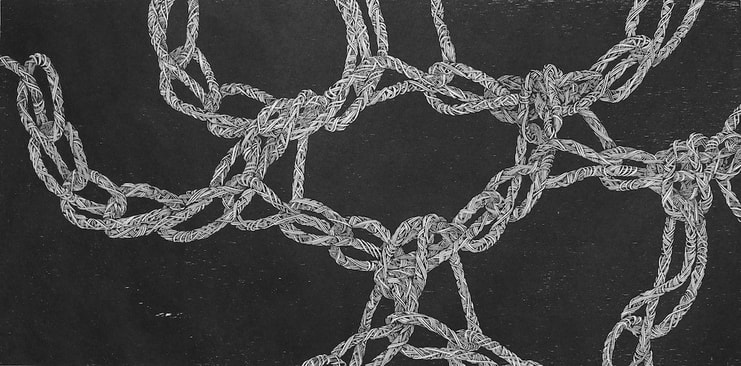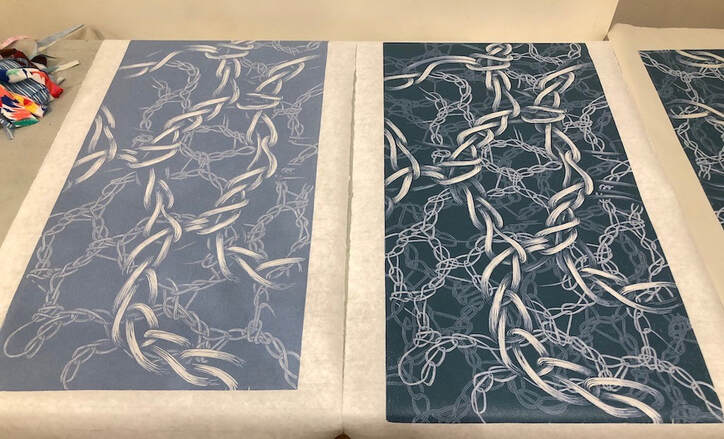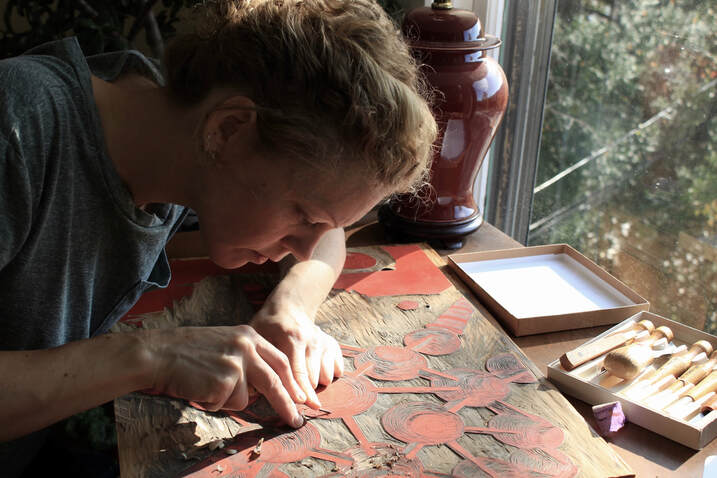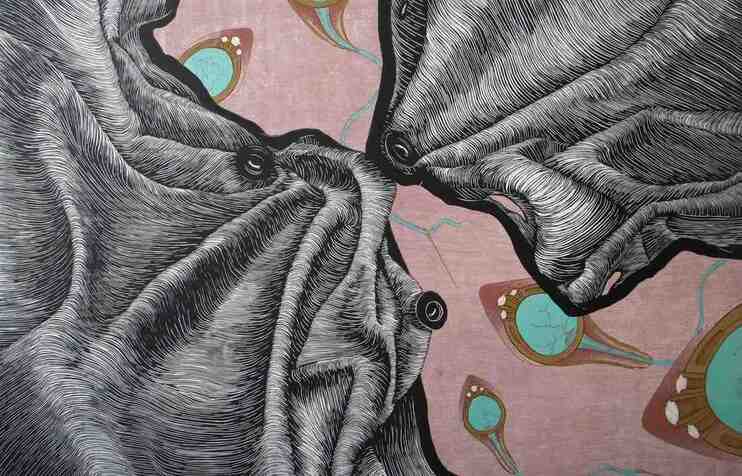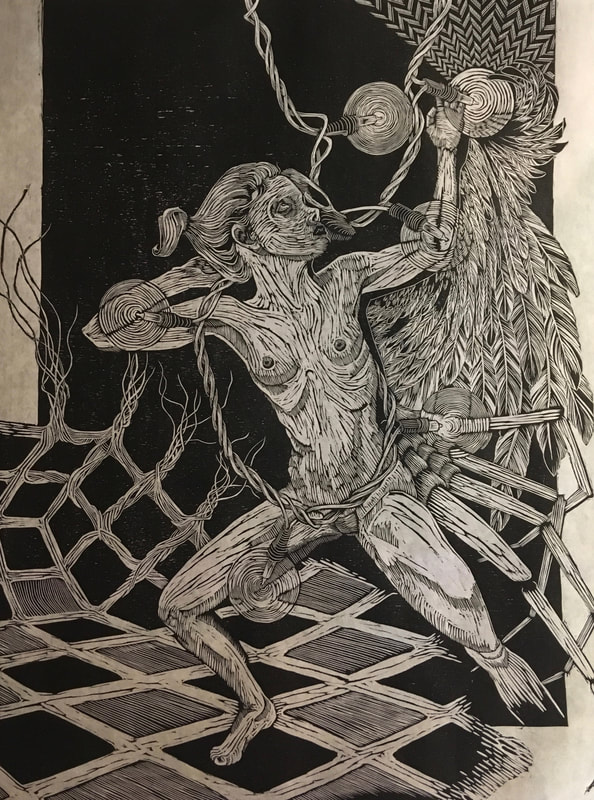Spotlight Artist Interview
Autumn Tomlinson
June 2020
SPA: We’re thrilled to have you as the recipient of SPA’s 2019-20 studio residency program. For those who may be unfamiliar with your work, can you tell us a little bit about what you are working on during your residency?
Autumn: During the residency at SPA I have been working on a body of work related to communication, connections and patterns of behavior. I have felt lucky in that, with all that is going on in the world and our community lately, this topic hasn’t lost its relevance to me. Granted it has shifted, and I have perhaps gone through bursts and lulls of artistic inspiration (or desperation) but overall it is tying itself together. With this project I began by drawing simple crochet patterns and then enlarging them. I then carved these patterns into 30”x 15” wood blocks.
Autumn: I have also been working on additional multi-color wood block prints that these knots patterns will be dropped on top of. Here are a couple photos of the layering process.
Autumn: There is a lot of repetition of imagery at different scales in these pieces. These elements are meant to act as a sort of “noise” aimed to distract from the elements that are crisply in focus. Following one of these lines from beginning to end proves hard in the way it wraps and folds over on itself. If you attempt to do so, you become involved in the act of unraveling it with your eyes. This is similar to following a line of thought or communication in an attempt to better understand and connect with each other.
I look at these individual strings as words or a train of thought. A communication line running from one person, or object, to another. The knots and patterns are created when connections are made, or misunderstandings take place, in an attempt to interpret the words and give meaning to them. How we are able to bring focus to, or cloud, the ideas we try to communicate? How do personal patterns of behavior dictate our interpretations of that meaning? Where do you, as the viewer, imagine they lead when they disappear off the page?
I look at these individual strings as words or a train of thought. A communication line running from one person, or object, to another. The knots and patterns are created when connections are made, or misunderstandings take place, in an attempt to interpret the words and give meaning to them. How we are able to bring focus to, or cloud, the ideas we try to communicate? How do personal patterns of behavior dictate our interpretations of that meaning? Where do you, as the viewer, imagine they lead when they disappear off the page?
SPA: I’m always curious about why artists feel an affinity for certain materials / processes. How did you know printmaking was “your” medium?
Autumn: I think a lot of my love of printmaking is rooted in the pottery that my parents made. I spent many days in my childhood watching my parents hand throw pottery. I watched their posture and the movements in their hands. Witnessing how the slightest change in either could alter the clay being shaped between their fingers. Watched them carve patterns into their pieces. And I would see the boards filling up with recurring shapes and found comfort in the repetition of it all.
Autumn: I think a lot of my love of printmaking is rooted in the pottery that my parents made. I spent many days in my childhood watching my parents hand throw pottery. I watched their posture and the movements in their hands. Witnessing how the slightest change in either could alter the clay being shaped between their fingers. Watched them carve patterns into their pieces. And I would see the boards filling up with recurring shapes and found comfort in the repetition of it all.
Autumn: I find the same comforting repetition in printmaking. The ability to make multiple images (and still maintain an ability to alter each one to be unique) makes me feel rich in practice. By that I mean it allows me to not become attached to a print as I might if it were singular object. It allows me to feel like I can experiment without being committed to the results. Registering images and watching layers build upon each other in just the right way is also incredibly satisfying. The fact that I can exercise a meticulousness of process and balance it with a loose use of imagery allows this medium to fulfill many needs in my creative process. I also love the poetic nature of woodblocks. How the act of carving away an image in the wood slowly builds the reverse image on paper. It seems like such a balancing act. A direct translation of negative to positive spaces in the building of an image. I think that in itself speaks to the subject matter of a lot of my work.
SPA: How do you find balance between your art-making practice and the daily obligations of life (jobs, community, etc.)?
Autumn: Balance. Ha. I don’t think I have quite mastered this one yet. I think balance is always something that I strive for but it has also been an elusive thing for me to attain and maintain. One of the goals that I set for myself upon moving to Vermont was to have art wrapped up in more of the ways that I make a living. Years of traveling and working contracts jobs abroad hasn’t allow for me to attain that goal since college, the two always felt very separate. Thus, I got a job working at the Vermont College of Fine Art upon moving to Montpelier. My thought being that if I can’t be making art full time right now, I can surround myself with a diverse group of people who are educating themselves and finding ways to incorporate the arts in their own lives. Working at VCFA I have been able to attend artist talks, author reading, concerts and gallery openings put on by artist from all over the US and the world. I also work at Beth Mueller Studios in Barre, a local business which makes slip casts pottery. This means of reproduction I have found an affinity for as well.
Finding a way to carve out time for my own art practice is hard and sporadic at times. There are always a 1000 different things pulling in 1000 different directions. But, I have also learned to look at my art practice as not only about the physical act of sitting down to draw, carve or print. I have learned that shifting my perspective is an important aspect of making art and I try to incorporate that idea into my everyday life. A silly example is…I sometimes spend 30 minutes in a day trying to do tasks with my eyes closed. That probably sounds strange, but there is so much you can learn from an object by seeing it with your fingers rather than your eyes. And the ways you translate what you feel can be a very playful creation of new visual objects. In doing these sorts of things I often find new solutions to problems or make new emotional connections with objects that are incorporated into my work.
To the part of me that strives for the regular routine and needing to set hours and deadlines I have said: you get 20 hours a week. I will be honest in that I am sometimes loose in regards to what I call art-making for those times. Sometimes I am carving well beyond that goal, and other times…I find myself calling a fly fishing excursion “art time” because I photographed all the interesting plants I got my fishing line caught on.
Autumn: Balance. Ha. I don’t think I have quite mastered this one yet. I think balance is always something that I strive for but it has also been an elusive thing for me to attain and maintain. One of the goals that I set for myself upon moving to Vermont was to have art wrapped up in more of the ways that I make a living. Years of traveling and working contracts jobs abroad hasn’t allow for me to attain that goal since college, the two always felt very separate. Thus, I got a job working at the Vermont College of Fine Art upon moving to Montpelier. My thought being that if I can’t be making art full time right now, I can surround myself with a diverse group of people who are educating themselves and finding ways to incorporate the arts in their own lives. Working at VCFA I have been able to attend artist talks, author reading, concerts and gallery openings put on by artist from all over the US and the world. I also work at Beth Mueller Studios in Barre, a local business which makes slip casts pottery. This means of reproduction I have found an affinity for as well.
Finding a way to carve out time for my own art practice is hard and sporadic at times. There are always a 1000 different things pulling in 1000 different directions. But, I have also learned to look at my art practice as not only about the physical act of sitting down to draw, carve or print. I have learned that shifting my perspective is an important aspect of making art and I try to incorporate that idea into my everyday life. A silly example is…I sometimes spend 30 minutes in a day trying to do tasks with my eyes closed. That probably sounds strange, but there is so much you can learn from an object by seeing it with your fingers rather than your eyes. And the ways you translate what you feel can be a very playful creation of new visual objects. In doing these sorts of things I often find new solutions to problems or make new emotional connections with objects that are incorporated into my work.
To the part of me that strives for the regular routine and needing to set hours and deadlines I have said: you get 20 hours a week. I will be honest in that I am sometimes loose in regards to what I call art-making for those times. Sometimes I am carving well beyond that goal, and other times…I find myself calling a fly fishing excursion “art time” because I photographed all the interesting plants I got my fishing line caught on.
SPA: You’re somewhat new to Vermont… how has your transition into a new art community been? Are you finding this to be a time of personal growth, discovery, clarity, etc...? Were there challenges?
Autumn: I celebrate my first year in Vermont this week and its so hard to believe! I think this last year has been a gradual, yet purposeful, transition into the local art community. I knew with the move to Vermont I wanted to shift my focus to be more inline with the art community and I feel, after a year of living in Vermont, that I have achieved a lot of those goals. I was going through my old journals as I was moving this last weekend and I found a list I had entitled “Five Year Plan: Take One” (Sept 9th 2017) As I read through it I couldn’t help but smile because I realized that half of the things I put on that list I have been able to achieve or attain since moving to Vermont. And that made me immensely happy and grateful. My residency at SPA has played a huge part in that. It felt really self-affirming to see my progress. I don’t know if I would be able to see it as clearly as I do now, if I hadn’t also changed so many other things in my life at the same time. But I also think that’s been a challenge. Sometimes it’s hard to find focus when your world seems so upended from what it once was. Its hard to give yourself credit when progress is made in one area of your life because it feels like you aren’t making enough progress in another. Again, the balancing act. So feel that this year had really been about all of those things you mention: personal growth, discovery, clarity.
Autumn: I celebrate my first year in Vermont this week and its so hard to believe! I think this last year has been a gradual, yet purposeful, transition into the local art community. I knew with the move to Vermont I wanted to shift my focus to be more inline with the art community and I feel, after a year of living in Vermont, that I have achieved a lot of those goals. I was going through my old journals as I was moving this last weekend and I found a list I had entitled “Five Year Plan: Take One” (Sept 9th 2017) As I read through it I couldn’t help but smile because I realized that half of the things I put on that list I have been able to achieve or attain since moving to Vermont. And that made me immensely happy and grateful. My residency at SPA has played a huge part in that. It felt really self-affirming to see my progress. I don’t know if I would be able to see it as clearly as I do now, if I hadn’t also changed so many other things in my life at the same time. But I also think that’s been a challenge. Sometimes it’s hard to find focus when your world seems so upended from what it once was. Its hard to give yourself credit when progress is made in one area of your life because it feels like you aren’t making enough progress in another. Again, the balancing act. So feel that this year had really been about all of those things you mention: personal growth, discovery, clarity.
SPA: Your artwork is incredibly rich with symbolism. Is there an ongoing narrative you are trying to communicate throughout your art? Are you more focused on telling individual stories?
Autumn: I am attracted to nooks and crannies and corners both literally and figuratively. Places where neglected accumulation happens. Like moving into a previously occupied space or someone else’s home. There always seem to be so much potential and yet there are always remnants of what came before. Places have scars, emotional and physical ones. I don’t mean that in a negative way. Scars are a reminder of lives lived. I love to find those reminders: height markers on doorways, a single earring, a key or a bead. Like pulling up the carpet in the corner of a room. Are the things you find precious and longed for or simply swept away by time and circumstance? It makes me feel connected to someone else’s story. I think that’s why I use seemly random objects in my work. I attempt to infuse them with symbolism, or to act as placeholders for people or emotions. Some objects have a lot of cultural symbolism ingrained in them already, which makes translation easier. Sometimes they are objects that marked a stage of my life. I think the narrative in my work draws a lot from my own individual story but also is an attempt at connecting to larger experiences that we all share.
Autumn: I am attracted to nooks and crannies and corners both literally and figuratively. Places where neglected accumulation happens. Like moving into a previously occupied space or someone else’s home. There always seem to be so much potential and yet there are always remnants of what came before. Places have scars, emotional and physical ones. I don’t mean that in a negative way. Scars are a reminder of lives lived. I love to find those reminders: height markers on doorways, a single earring, a key or a bead. Like pulling up the carpet in the corner of a room. Are the things you find precious and longed for or simply swept away by time and circumstance? It makes me feel connected to someone else’s story. I think that’s why I use seemly random objects in my work. I attempt to infuse them with symbolism, or to act as placeholders for people or emotions. Some objects have a lot of cultural symbolism ingrained in them already, which makes translation easier. Sometimes they are objects that marked a stage of my life. I think the narrative in my work draws a lot from my own individual story but also is an attempt at connecting to larger experiences that we all share.
Autumn: You can see this in my piece “A Memory” (above). The black and white portions of the print are the close up image of a door with a small crack to see what is behind it. Doors and doorways are heavy with symbolism in their own right. They mark a transition from one place to another. The potential for movement forward. But doorways also imply that action needs to be taken. Do you open it and go through the threshold?
When I was a kid my parents had a pottery studio that was down the hill from our home. At night after we were put to bed they would light a fire in the stove and set to work. The shop had a huge wooden door on rollers. I still remember the sound it made when it was opening or closing. It was too heavy for me to move…but it never quite closed all the way. There was always a small sliver of light that snuck out from behind it. I have memories of waking up in the night and being scared that my parents weren’t there. I would sometimes walk through the dark, down the hill to the shop, so that I could peer into the small sliver of the door opening and see my parents working. And that was so comforting. Its funny because when I think of it now I am surprised that the dark walk didn’t deter me.
The landscape beyond the door is one with a gradated sky. It is meant to be an ambiguous light that one can see on the horizon near sunrise or sunset. I feel that these periods represent both the end and beginning of something.
The teeth are seen as falling or floating in the space. As a child the losing of my teeth felt like a right of passage. As an adult I had dreams of losing my teeth and with them a sense of control. As a child you smile with pride. As an adult you feel a sense of embarrassment.
I think it's interesting how perspective changes for yourself over time. How reliving the same experience at different stages of your life has such significantly different outcomes or impacts. And conversely, how other people living such different experiences can come to the same result. In telling my own story, utilizing symbolism, I feel like it allows me to tell other peoples stories as well. The story of me seeking out the comfort of my parents is my own. But I think everyone walks through the dark at some point in their life, following a sliver of light. And when they get to the door on the other side they either peer at it and walk away…or they gain their strength and open it.
When I was a kid my parents had a pottery studio that was down the hill from our home. At night after we were put to bed they would light a fire in the stove and set to work. The shop had a huge wooden door on rollers. I still remember the sound it made when it was opening or closing. It was too heavy for me to move…but it never quite closed all the way. There was always a small sliver of light that snuck out from behind it. I have memories of waking up in the night and being scared that my parents weren’t there. I would sometimes walk through the dark, down the hill to the shop, so that I could peer into the small sliver of the door opening and see my parents working. And that was so comforting. Its funny because when I think of it now I am surprised that the dark walk didn’t deter me.
The landscape beyond the door is one with a gradated sky. It is meant to be an ambiguous light that one can see on the horizon near sunrise or sunset. I feel that these periods represent both the end and beginning of something.
The teeth are seen as falling or floating in the space. As a child the losing of my teeth felt like a right of passage. As an adult I had dreams of losing my teeth and with them a sense of control. As a child you smile with pride. As an adult you feel a sense of embarrassment.
I think it's interesting how perspective changes for yourself over time. How reliving the same experience at different stages of your life has such significantly different outcomes or impacts. And conversely, how other people living such different experiences can come to the same result. In telling my own story, utilizing symbolism, I feel like it allows me to tell other peoples stories as well. The story of me seeking out the comfort of my parents is my own. But I think everyone walks through the dark at some point in their life, following a sliver of light. And when they get to the door on the other side they either peer at it and walk away…or they gain their strength and open it.


